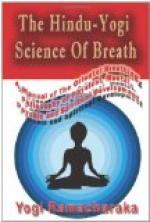Before taking up the Western idea, it will perhaps be better to give a hasty general idea of the Organs of Respiration.
The Organs of Respiration consist of the lungs and the air passages leading to them. The lungs are two in number, and occupy the pleural chamber of the thorax, one en each side of the median line, being separated from each other by the heart, the greater blood vessels and the larger air tubes. Each lung is free in all directions, except at the root, which consists chiefly of the bronchi, arteries and veins connecting the lungs with the trachea and heart. The lungs are spongy and porous, and their tissues are very elastic. They are covered with a delicately constructed but strong sac, known as the pleural sac, one wall of which closely adheres to the lung, and the other to the inner wall of the chest, and which secretes a fluid which allows the inner surfaces of the walls to glide easily upon each other in the act of breathing.
The Air Passages consist of the interior of the nose, pharynx, larynx, windpipe or trachea, and the bronchial tubes. When we breathe, we draw in the air through the nose, in which it is warmed by contact with the mucous membrane, which is richly supplied with blood, and after it has passed through the pharynx and larynx it passes into the trachea or windpipe, which subdivides into numerous tubes called the bronchial tubes (bronchia), which in turn subdivide into and terminate in minute subdivisions in all the small air spaces in the lungs, of which the lungs contain millions. A writer has stated that if the air cells of the lungs were spread out over an unbroken surface, they would cover an area of fourteen thousand square feet.
The air is drawn into the lungs by the action of the diaphragm, a great, strong, flat, sheet-like muscle, stretched across the chest, separating the chest-box from the abdomen. The diaphragm’s action is almost as automatic as that of the heart, although it may be transformed into a semi-voluntary muscle by an effort of the will. When it expands, it increases the size of the chest and lungs, and the air rushes into the vacuum thus created. When it relaxes the chest and lungs contract and the air is expelled from the lungs.
Now, before considering what happens to the air in the lungs, let us look a little into the matter of the circulation of the blood. The blood, as you know, is driven by the heart, through the arteries, into the capillaries, thus reaching every part of the body, which it vitalizes, nourishes and strengthens. It then returns by means of the capillaries by another route, the veins, to the heart, from whence it is drawn to the lungs.




